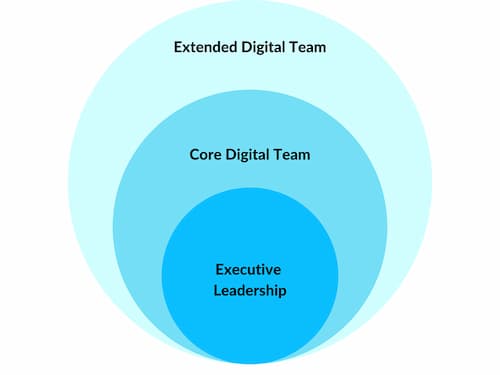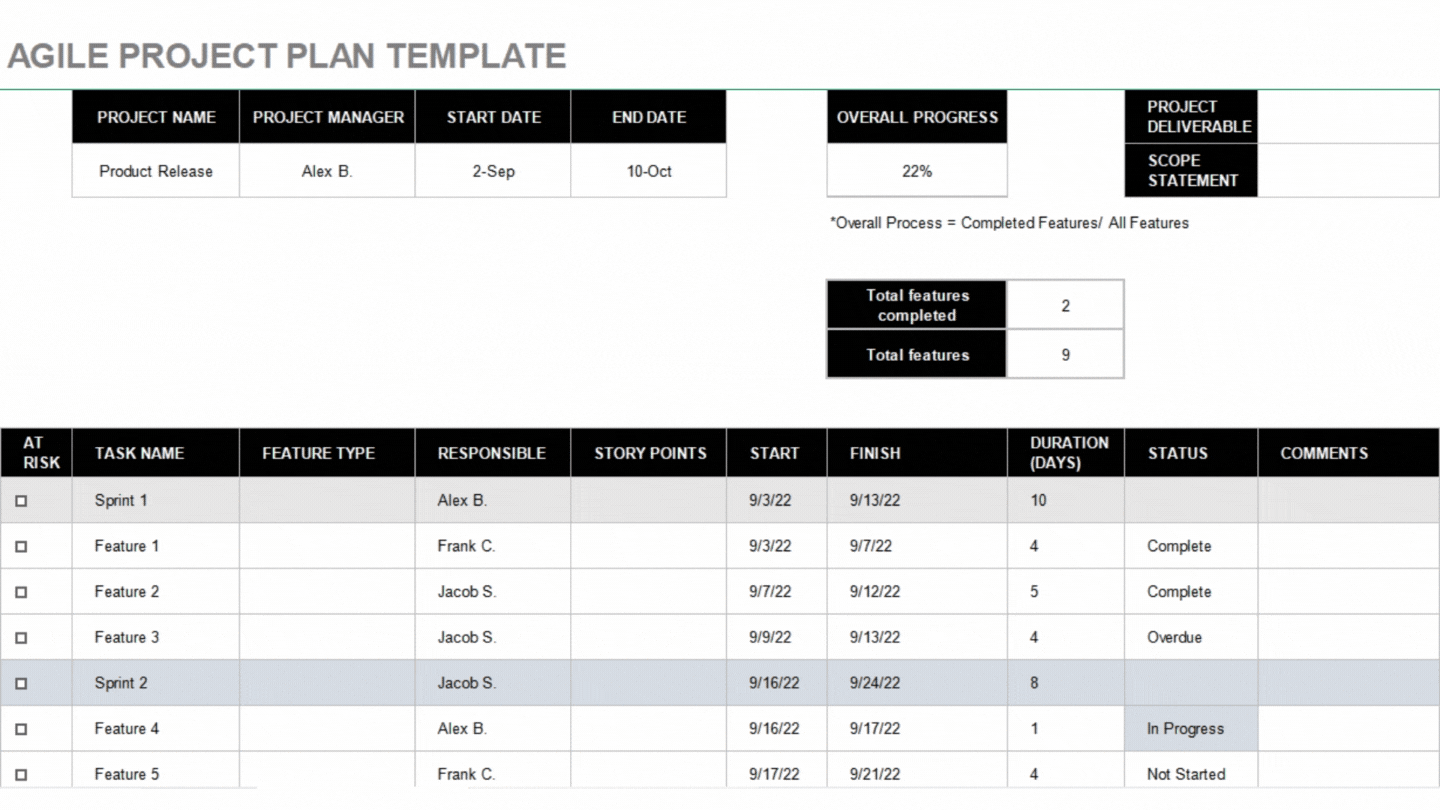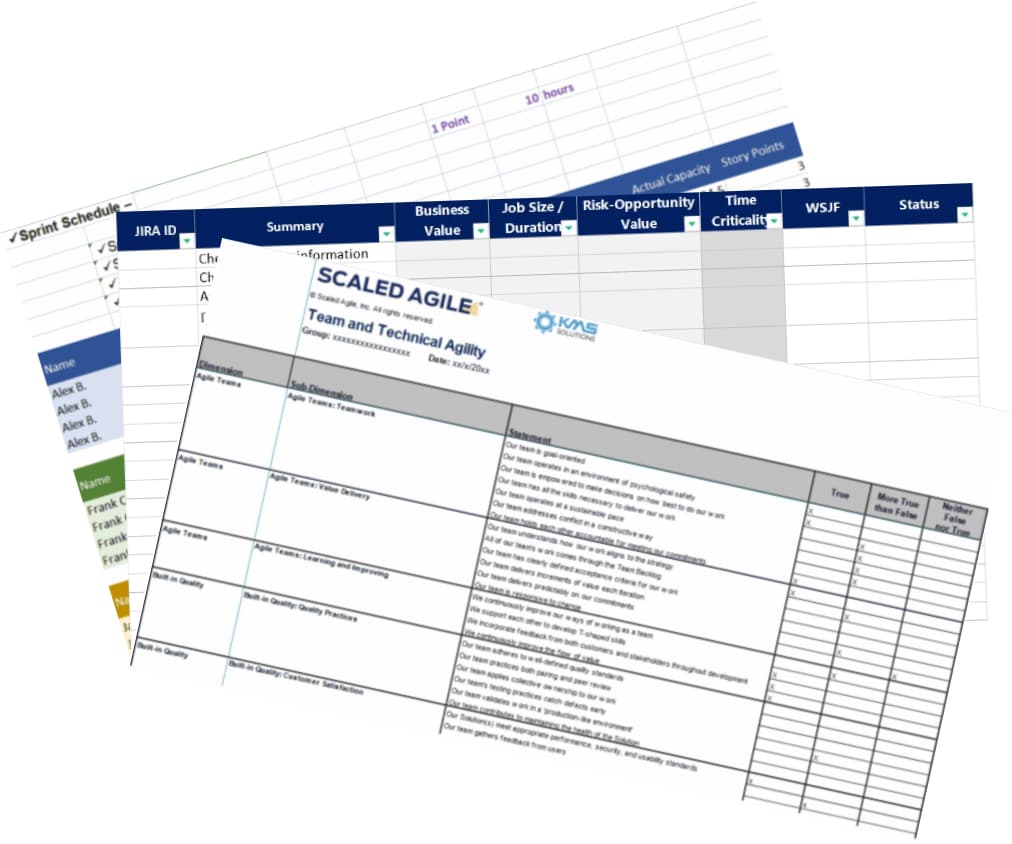Digital Team Knowledge Center
The ultimate guide to the Agile digital team and How to manage one effectively

Free Project Management Template
Outline an action plan, predict the project's duration, and measure workload capacity in one simple, coherent template.

What is a Digital Team?
A Digital Team is a group of cross-functional individuals that help you take full responsibility for your product, grow your internal development team, and simply make up for the gaps in your capabilities. This model ensures all team members are working in high synergy towards a single goal: making Digital Transformation happen. If a Digital Team is a framework, there will be three layers to it: Executive Leadership, Core Digital Team, and Extended Transformation Team.

Services that require a digital team include Application and Software Development, Data Analysis, Software Testing, Technical Consulting, IT Management Services, and Technical Support.
For any technical-related project, choosing team members with the necessary skills is among the biggest challenges, along with project leadership and management. Important roles included in a typical digital team are: The project manager (PM), IT specialists, Data engineers, UI/UX designers, and QA/QC engineers. A high-performance digital team will need to implement Agile methodology since it plays an essential role in the effectiveness of the project and team management
How to Onboard Digital Team and Transfer Knowledge?
.png)
There are three crucial phases of hiring the digital team: Initiation, Onboarding & Knowledge Transfer, and Steady State with agile delivery governance in place for execution.
1. Initiation
Prior to the formal commencement, the initiation phase ensures that both parties are well-prepared for their impending responsibilities. This phase normally lasts one week and consists of four key activities:
- Resource ramp-up for a core team
- Access to environment and documentation
- Access to related tools and technology stack
- Kick-off
2. Knowledge transition
The Onboarding and Knowledge Transition phases will be carried out in accordance with the established plan after the Initiation phase has been finished.
During this time, the ramp plan can be adjusted as needed to adapt to changing circumstances and still impart product knowledge by the due date. For a greenfield project, a week before formal team membership, the resources must be fully ramped up in terms of skills and project training. There are three sub-phases in this progress:
- Product Exploration (2-4 weeks)
- Product in depth (2-4 weeks)
- Hands-on (4 weeks)
3. Steady State
The team may begin executing and delivering at its full capacity and growing productivity over time when it has been fully onboarded with all the necessary knowledge, tools, and hands-on experiences to follow the Agile development approach established.
How to Evaluate a Digital Team’s Performance?
With the emergence of Agile, there are six key performance indicators (KPIs) that can be used to evaluate a digital team's performance:
1. On-Budget
The first thing that project managers of the digital team need to pay more attention to is the budget. Recognizing potential overruns on time can help the digital team avoid unpleasant surprises and save resources for other phases of development. There are three essential areas to consider when estimating the project's budget:
- Availability of resources (headcount and associated dollar budget)
- Resources for development operations
- Resources for network operations progress.
2. On-time Delivery
Project managers in an Agile development team will be responsible for managing the timely preparation of all deliverables and ensuring that the plan's budget is sufficient.
As delays can occur at any stage during the product development cycle, the project managers or Scrum master will need to track the work of team members regularly and compare the plan to the actual progress.
Use a high-level Agile Project Plan Template to estimate duration of tasks, person in charge, status of each task, and more.

3. Process Improvements
The digital team also needs to put more effort into challenging and improving procedures on a regular basis. Improvements to processes can help you save time
- By eliminating needless dependencies.
- By having specific tasks run automatically, you may save money.
- Simplify engagements and enhance the customer experience to boost their satisfaction.
4. Relationships and Communication
Communication is one of the primary determinants of an effective digital team. This is also one of the main characteristics of a high-performance digital team. Good team discussion not only decreases unnecessary time sinks but also keeps all members on the same page and neutralizes redundancies, disjointed information, and mistakes - all of which can equally impede productivity. Moreover, speaking with personnel from various departments can give a 360-degree overview of the project's process, comprising any challenges or issues that your team members are having.
5. Risk Management
Every project has risks; however, they may be disregarded or controlled. One way to measure the performance of the digital team is to examine their preparation, and the consequences of their actions is one standard to evaluate them. The project manager will be in charge of creating a risk mitigation strategy to determine which hazards need to be addressed.
6. Customer Orientation
It's essential to implement a customer-centric development strategy. The team must ensure that their product meets user requirements and is receptive to any feedback in order to enhance the quality. Listen for the win-win mentality that balances consumer goals with business objectives when measuring the team's performance.
How to Set Budget and Forecast your Digital Team?
Budgeting is always an obstacle as projects tend to change rapidly and frequently, and the purpose may shift, resulting in overspending. However, one of the digital team's greatest benefits is its focus on adaptation and agility. So, much more effortless than a traditional waterfall project management, you can anticipate the budget and forecast the digital team needed easily by concentrating on these aspects:
1. Establish Context and Set Expectations
The first thing is to understand why a client is developing a product or service. Moreover, you should also know the client's end users to focus on value, set project priorities, and ensure the final product can meet their primary requirements.
By considering the factors that might cause cost variations, you can establish whether the predicted outcome is feasible within the client's financial constraints, and from that, work with them to make necessary adjustments. Lastly, you should establish the client's expectations by ensuring that they are familiar with the Agile principles.
2. Calculate and Adjust
Digital teams can use various estimating methodologies to identify the scope, risk, and complexity of each requirement when kicking off a project and once all client expectations have been grasped. Based on the size and cost of the team, as well as the duration and number of sprints, you may estimate the entire time and money required for the project.
The expenditures for each phase of the project is varied based on different teams' rate cards. Controlling the budget effectively requires keeping track of project velocity when it progresses. It'll help you consider whether your assessments are realistic or need to be altered.
3. Involve Clients in the Process
Client cooperation is a key element of Agile methodologies. You may ensure the project remains on schedule by communicating with clients often, preferably after each sprint. Thus, changes to requirements can be accommodated immediately, resulting in reduced costs. By involving clients in the development process, they can help you prioritize the backlog and decide which features to add or eliminate. This will affect you substantially as it helps you focus on the main point and reduce time wasted on unnecessary tasks.
4. Balance the Budget
The key to managing the budget for the digital team projects is to put more concentration on the time, talents, and money you have, while keeping an open mind and communicating openly to allow for genuine adaptability.
Must-have Tools for the Digital Team
Tools for Planning and Managing your Digital Team
- Jira: is an all-in-one comprehensive Jira management tool that helps you visualize all the work being done in a sprint, and track each task's duration and the person in charge.
- Toggle offers an intuitive timeline that helps digital teams streamline planning. By using this tool, you can create monthly, quarterly, and annual overviews of the project to have a long-term perspective.
Besides those tools, you can also plan and track the digital team's performance using Excel files. We recommend downloading the following templates to create your plan.
Feature Resources: Project Management Planning Template

Tools for Source Control and Collaborate
- Git: is a distributed version control system that tracks source code modifications (DVCS). It records modifications in many virtual systems rather than a single dominant central repository. It prioritizes efficiency and data integrity and is ideal for nonlinear processes such as Agile.
Tools for Finding and Fixing Bugs
- Backlog: this is ideal for backlog management, the tool can help you record bugs, crunch data, and track the testing team's performance.
- Katalon: is a well-known test automation solution that is best suited for Continuous Testing and DevOps. With its comprehensive reporting, real-time monitoring, and quick feedback system, Katalon simplifies your process of monitoring product quality, performance, and associated issues.
As a team member or manager, it's important to look after the performance of the testing process to guarantee the product's release velocity and software quality.
Map out your test plan, review the testing process, and record bugs immediately with this collection of Testing template
.jpg)
Related articles
25Jul
DevOps Best Practices to Help IT Teams Build Great Software
04Jul
Effective Ways for DevOps Team to Take Advantage of AI
15Jun
Productivity Metrics to Benchmark Dedicated Software Development Team
13Jun
CIO Strategy: Hiring a Vietnamese Software Team for Australian BFSI Company
08Jun
9 DevOps Team Structures to Achieve Continuous Delivery
Get a customized Digital Team that helps grow your business!
Book a Demo for Digital Team
* By clicking on the submit entry button and submitting this form you will be indicating your consent to receiving our service consultation and marketing materials.